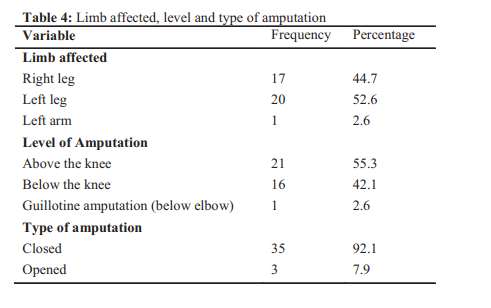Profile of limb amputations in UNIOSUN Teaching Hospital, SouthWestern, Nigeria
Keywords:
DFU, Malignant tumor, peripheral vascular diseaseAbstract
Background: Limb amputation constitute a public health challenge by it's shared burden, aside from the socioeconomic and psychological distress including discriminatory effects on the patients and thier families. This study was done to determine epidemiological pattern of amputation at Uniosun Teaching Hospital, Osogbo.
Methodology: This was a retrospective study of the amputations carried out by the Orthopaedic Unit of Surgery department at UNIOSUN Teaching Hospital, Osogbo between July, 2021 and May, 2022. All records of patients were retrieved and selected data collected were the indications, level, side and type of amputations and the patients' religion, age and sex.
Results: The mean age of the 38 patients was 50.5±18.1 years. Male to female ratio was 4 to 1.
The commonest indication for amputation was Diabetic foot Ulcer (DFU) grade iv (60.5%) followed by RTA (28.9%) and 10.6% from limb Malignant tumour and peripheral vascular disease. In terms of affected limb, more than half of respondents had their left leg affected i.e 20 (52.6%) and majority of amputations done were above the knee 21 (55.3%).
Conclusion: DFU grade iv and RTA were the commonest causes of amputation in our center which can be prevented by early presentation, early detection and appropriate management.
References
Paundel B, Strestha BK, Banskota Ak. Two faces of Major Lower Limb Amputations. Kathmandu Univ Med J. 2005; 3(3): 212 -216
Van der M, Wi KN. No leg to stand on: Historical relation between amputations. Surgery and Prostheseology J. 1995; 1:1-256)
Akhator A. Pattern of Lower Limb Amputation in Eku. Ebonyi Medical Journal. 2007; 6(1) :18-20
Diao S, Masse A, Diouf J, Sane J, Thiam B, Diallo M, etal. Major Limb Amputation:
Etiological and Clinical profile in a Hospital in
Sub- Sahara Africa. Open Journal of
orthopaedic. 2021; 11: 40 – 46
Thann LO, Tade AO. Extremity Amputation in Nigeria- a review of indications and mortality. Surgeon. 2007; 5(4): 213 – 217
Amaefule KE, Dairu IL. Profile of Major Limb Amputation in Zaria North West Nigeria: an Emerging Trend in a Dynamic Nation. Nigeria Journal of Orthopaedic and Trauma 2015; 14: 2
Abou-Zamzam AM, Teruya TH, Killeen JP,
Ballard JL. Major Lower Exremity amputation in an academic vascular center. Annn Vasc Surg. 2003; 17(1): 86-90
Olasinde AA, Oginni LM, Bankole JO,
Adegbehingbe Y, Oluwadiya KS. Indication for Amputations in Ile-Ife, Nigeria. Niger J Med. 2002; 11(3): 118-121
An Introduction to Orthopaedic, Department of Orthoaedic Surgery. AAU – Medical Faculty. 1994: Pp 1-77.
National Limb loss Information Centre fact sheet , Amputation Statistics by Cause Limb Loss in the United State, Revised 2008 (Reviewed on October 14, 2011)
Soomro N, Bibi R, Ahmed SI, Kamran B, Minhas
MA, Siddiqui MY. Epidemiology of
Amputation: low resource Community: Sindh
Province, Pakistan. Professional Med J 2013; 20(2): 261-265
Naaeder SB. Amputation of the Lower Limb in Korle- Bu Teaching Hospital, Accra. West Afr J Med. 1993; 12: 21-26
Chalya PL, Manila JB, Dass RM, Ngayomela IH, Chandika AB, Mbelenge N. Major Limb
Amputation: A Tertiary hospital experience in North Western Tanzania. Journal of Orthopaedic Surgery and Research. 2012; 7: 18
Doumi EA, Ali AJ. Major Limb Amputation in Ei Obeid Hospital, Western Sudan. Sudan JMS.
; 2(4): 237-239
Servestani AS, Azam AT. Amputation: A TenYear Survey. Traums Mon. 2013 December; 18 (3): 126 – 129
Traulner C, Haasten B, Spraul M, Giani G, Berger M. Unchanged incidence of lower limb amputations in a German city, 1990 -1998. Diabetic Care J. 2001; 24: 855
Dangelser G, Beson S, Gatina J, Blickle I. Amputations among diabetes in Reunion Island. Diabetes Metab. 2003; 29: 628-34
Thanni LO, Tade AO, Extremity Amputation in Nigeria- A review of indications and mortality. Surgeon J. 2007; 5: 213 -217

Downloads
Published
How to Cite
Issue
Section
License
Copyright (c) 2023 Research Journal of Health Sciences

This work is licensed under a Creative Commons Attribution-NonCommercial-NoDerivatives 4.0 International License.
Research Journal of Health Sciences journal is a peer reviewed, Open Access journal. The Journal subscribed to terms and conditions of Open Access publication. Articles are distributed under the terms of Creative Commons License (CC BY-NC-ND 4.0). (http://creativecommons.org/licences/by-nc-nd/4.0). All articles are made freely accessible for everyone to read, download, copy and distribute as long as appropriate credit is given and the new creations are licensed under the identical terms.

